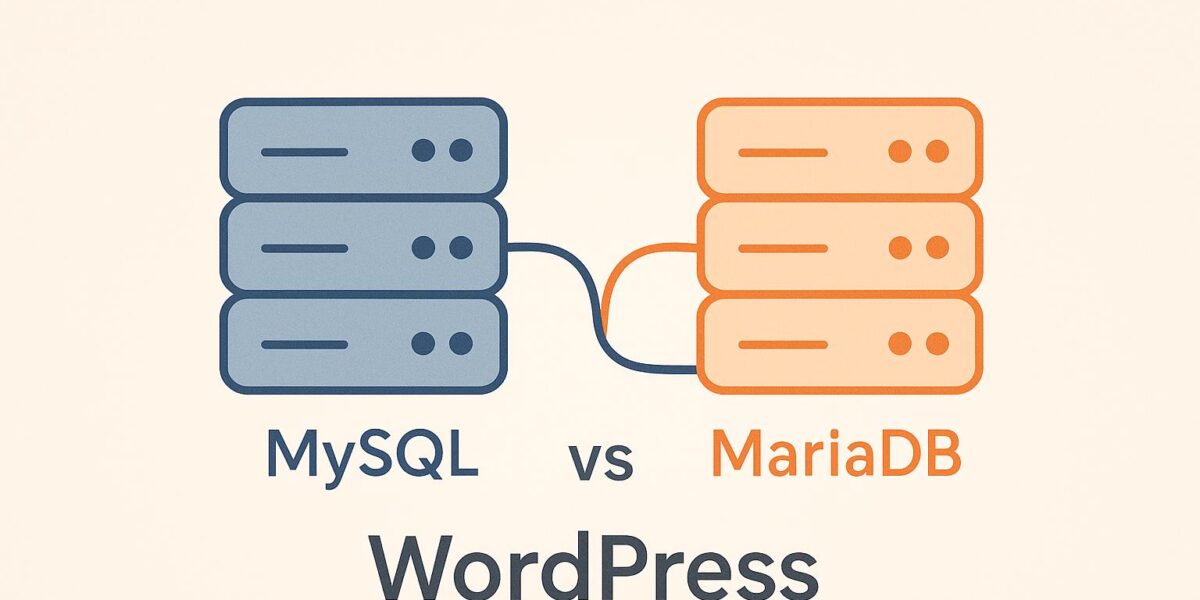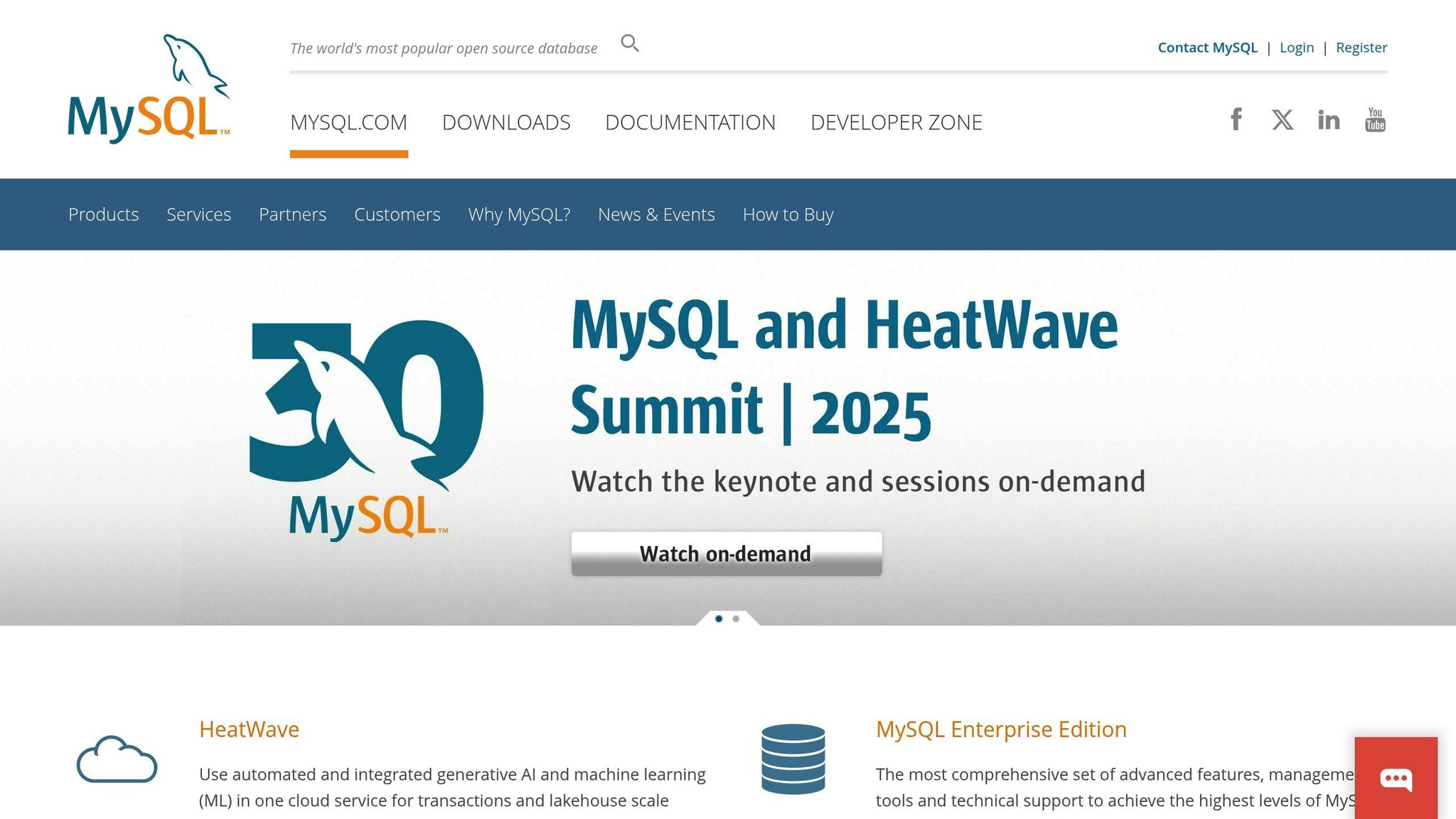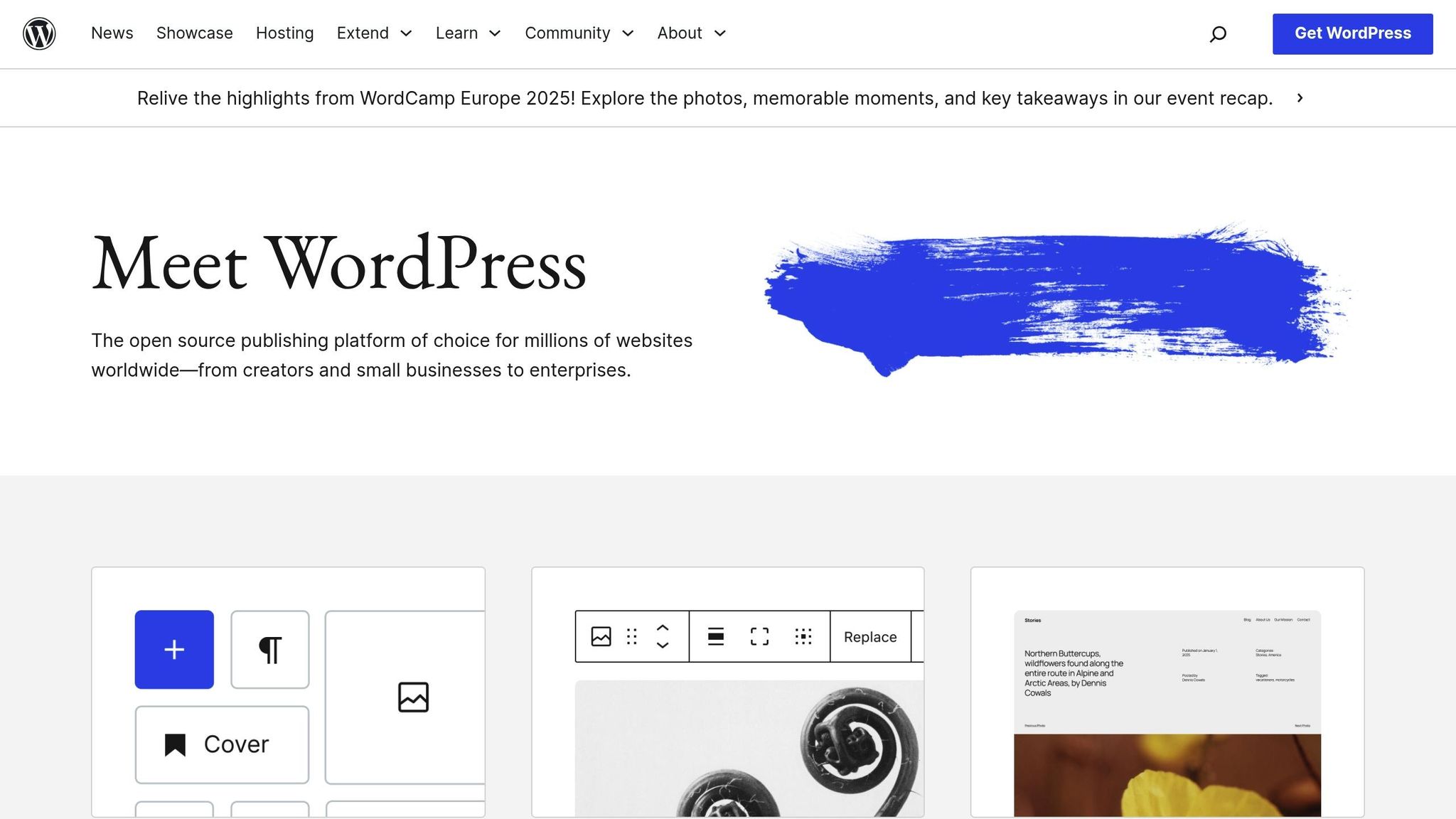MySQL vs MariaDB for WordPress

Which database is better for WordPress: MySQL or MariaDB?
If you’re running a WordPress site, choosing between MySQL and MariaDB can directly impact your site’s speed, scalability, and reliability. Here’s a quick summary to help you decide:
- MariaDB: Faster for complex queries, handles high traffic better (200,000+ connections), advanced security features, fully open-source, and quicker updates. Ideal for high-traffic or growing WordPress sites.
- MySQL: Reliable, widely supported by hosting providers, and better suited for simpler setups or smaller sites.
Quick Comparison
| Feature | MariaDB | MySQL |
|---|---|---|
| Performance | Advanced query optimizations, thread pooling | Standard optimizations |
| Scalability | Handles high traffic (200,000+ connections) | One-thread-per-connection model |
| Security | Table-level encryption, advanced plugins | Basic encryption features |
| Open-Source | Fully GPL-licensed | Dual license: GPL + proprietary |
| Replication | Galera Cluster, multi-source | Group replication available |
| Hosting Compatibility | Supported by many providers | Universally supported |
Key Takeaway: Use MariaDB if you need high performance and scalability. Choose MySQL for reliability and simpler hosting setups.
Top Database Expert Reveals MySQL vs MariaDB Speed Secrets

Main Differences Between MySQL and MariaDB
MySQL and MariaDB share the same roots but have evolved to serve distinct roles, especially for WordPress users. Knowing what sets them apart can help you make the best choice for your WordPress site.
Ownership and Community Support
One of the biggest differences lies in who controls them. MySQL is owned by Oracle Corporation, a major enterprise software company that took over in 2010. This means Oracle sets MySQL’s development priorities based on its business goals.
MariaDB, on the other hand, operates under a community-driven governance model. Decisions about its development are made collectively by contributors and the MariaDB Foundation, ensuring it remains independent of any single corporate agenda.
Interestingly, 5,813 developers working with MySQL have expressed interest in switching to MariaDB. This growing preference highlights the appeal of a more community-focused approach. These differences in governance also influence how features are developed, making it worth exploring their technical distinctions.
Licensing and Open-Source Approach
The two databases also differ in their licensing. MySQL offers a dual licensing model: a GPL community version and a proprietary option. Companies wanting to use MySQL without open-sourcing their own software must purchase a commercial license from Oracle.
MariaDB, however, is fully GPL-licensed. This ensures it remains free to use and aligns seamlessly with WordPress’s own GPL philosophy. MariaDB’s licensing encourages wider community contributions, often leading to faster updates and feature rollouts compared to MySQL’s corporate-driven approach. Now, let’s dive into the technical features that directly impact WordPress performance.
Feature Comparison Table
Here’s a breakdown of key technical differences:
| Feature | MariaDB | MySQL |
|---|---|---|
| Storage Engines | InnoDB, Aria, MyISAM, TokuDB, XtraDB, ColumnStore | InnoDB, MyISAM, Aria, NDB, TokuDB |
| Thread Pooling | Advanced thread pool (200,000+ connections) | One-thread-per-connection model |
| JSON Functions | JSON_QUERY, JSON_EXISTS, and standard functions | JSON_TABLE, standard functions |
| Replication | Galera Cluster, multi-source replication | Asynchronous, semi-synchronous, group replication |
| Security Features | Data-at-Rest Encryption, table-level encryption | Basic encryption features |
| Oracle Compatibility | PL/SQL support, Oracle procedures/sequences | Limited Oracle compatibility |
| Query Optimization | Enhanced subquery optimizations, multi-threading | Standard MySQL optimizations |
| Analytics Support | Advanced analytics with ColumnStore | Basic analytics (Enterprise has more) |
MariaDB offers a wider range of storage engines, such as XtraDB and ColumnStore, giving WordPress users more flexibility for handling data. These engines can significantly boost performance for high-traffic or data-heavy sites.
Its advanced thread pooling is another standout feature. With the ability to manage over 200,000 connections simultaneously, MariaDB handles heavy traffic more efficiently than MySQL’s one-thread-per-connection model.
Additional advantages include MariaDB’s unique JSON functions and enhanced query optimization capabilities, which can lead to faster page load times and better overall performance. Thanks to its community-driven approach, MariaDB often adopts new features more quickly, making it a strong option for WordPress sites that need scalability and efficiency.
Performance Comparison for WordPress Hosting

When running WordPress sites, the performance of your database plays a huge role in how fast your pages load and how stable your site remains. The way your database processes queries, handles multiple connections, and manages resources directly affects your site’s speed and its ability to perform under heavy traffic.
Query Speed and Optimization
MariaDB is known for processing complex WordPress queries nearly twice as fast as MySQL, which means faster page load times. One of its standout features is advanced query optimization, which breaks queries into multiple threads for better efficiency. For example, INSERT statements in MariaDB’s memory storage engine can execute 24% faster.
That said, MySQL 8 has made significant strides in performance compared to earlier versions, even surpassing MariaDB 10.3 in some areas. Additionally, MariaDB includes subquery optimizations, which are especially useful for WordPress themes and plugins that depend on complex database relationships.
While query speed is critical, managing connections efficiently is just as important for sites with high traffic.
Replication and Connection Handling
Beyond query execution, connection management and data replication are key for maintaining performance during traffic spikes. MariaDB’s advanced thread pooling allows it to handle over 200,000 connections simultaneously, a big step up from MySQL’s one-thread-per-connection model.
MariaDB also offers powerful replication options. Its Galera Cluster supports high availability and synchronous replication, while features like multi-source replication and global transaction IDs simplify managing complex setups. These tools make MariaDB a strong choice for distributed environments requiring sharding or high availability. Meanwhile, MySQL continues to perform well in more traditional configurations.
Resource Usage Under Load
Handling resource usage efficiently under heavy traffic is critical for WordPress performance. MariaDB’s thread pooling shines here, making it a strong choice for shared or resource-limited servers.
For MySQL, optimization efforts have shown impressive results, such as reducing server response times from 860 milliseconds to 250 milliseconds and increasing queries per second by 106%. However, MariaDB’s architecture is designed to maintain consistent performance even as traffic fluctuates.
Memory management is another area where MariaDB excels. It relies heavily on memory for query processing and caching, which makes proper memory allocation crucial. When given sufficient resources, MariaDB can deliver consistent performance, even during unpredictable traffic surges. This efficient use of memory and resources gives MariaDB a noticeable advantage for WordPress sites that experience variable traffic patterns.
sbb-itb-d55364e
Security and Stability Features
When it comes to WordPress, your database is the backbone of your site, holding all your valuable data. With WordPress powering over 40% of websites globally, it’s no wonder it’s a top target for automated attacks. This makes the security and update practices of your database absolutely critical for keeping your site safe.
Advanced Security Features in MariaDB
Both MySQL and MariaDB come equipped with essential security tools like encryption, access control, and SSL/TLS support. But MariaDB takes it a step further, offering extra layers of protection that aren’t included in standard MySQL versions. For instance, MariaDB version 10.4 introduced the ed25519 authentication plugin, which replaced the older SHA-1 method for better password security. On top of that, MariaDB includes three password validator plugins, giving users more options compared to MySQL’s single validate_password tool.
MariaDB also goes beyond MySQL by encrypting binary logs and temporary tables, whereas MySQL only encrypts redo and undo logs. These additional encryption measures are especially important for WordPress sites that deal with sensitive data like customer information, payment details, or personal records. These features highlight just how critical security updates are, which leads us to the importance of development cycles.
Development and Update Cycles
Keeping your database updated is a key part of maintaining WordPress security and stability. MariaDB’s community-driven development approach allows for quicker feature releases and security patches, while MySQL’s open-source version tends to have slower update cycles. This difference matters because timely updates help shield your site from known vulnerabilities and exploits. When combined with regular updates to WordPress core, themes, and plugins, prompt database updates become a cornerstone of your site’s overall security strategy.
Practical Considerations for WordPress Sites
When managing a WordPress site, it’s essential to think about practical factors that influence both daily operations and long-term growth. These considerations help connect technical choices with real-world outcomes.
Compatibility and Migration Process
MariaDB is designed to be a straightforward replacement for MySQL, making migration for most WordPress sites relatively simple. According to MariaDB (mariadb.com):
"MariaDB is a binary compatible 1:1 replacement for MySQL"
This compatibility often extends to WordPress plugins and themes, meaning they usually work without needing any changes. However, ensuring version compatibility is critical:
| MySQL Version | Compatible MariaDB Versions |
|---|---|
| 5.1 | 5.1, 5.2, 5.3 |
| 5.5 | 5.5 |
| 5.6 | 10.0, 10.1 |
| 5.7 | 10.2, 10.3, 10.4, 10.5 |
| 8.0 | No direct compatibility |
For sites running MySQL 8.0, you’ll need to use the mysqldump utility to export your database before importing it into MariaDB. If SHA256 password hashing is enabled in your MySQL setup, reset those user passwords prior to migration. Afterward, update the wp-config.php file with your new database credentials and run mysql_upgrade to finalize the transition. Upgrading both databases to their latest versions beforehand can also prevent compatibility issues.
Once migration is complete, it’s worth assessing how your database choice aligns with your site’s future growth plans.
Long-Term Growth and Scalability
MariaDB doesn’t just match MySQL in functionality – it’s also built to handle expansion effectively. For WordPress sites, this means faster replication speeds and better performance with features like the RocksDB engine, which excels at managing views and flash storage.
"MariaDB is a great fit for WordPress, as it is a fork of MySQL and offers similar syntax and functionality. In fact, many WordPress hosting providers offer MariaDB as a database option by default. Likewise, the service includes many improvements and optimizations over MySQL, especially in the areas of performance and scalability." – bloggerpilot.com
MariaDB’s open-source nature ensures ongoing updates and community contributions, making it particularly appealing for e-commerce stores, membership platforms, or other WordPress sites with large datasets and ambitious growth plans.
Hosting Provider Support
Another practical consideration is whether your hosting provider supports MariaDB. Many hosting companies now offer MariaDB as a standard or optional database choice, which simplifies the setup and minimizes compatibility concerns.
For tailored advice, you might want to consult a hosting broker. Services like Osom WP Host can provide personalized recommendations based on your specific needs for performance, scalability, and security, helping you align your hosting environment with your long-term WordPress goals.
Choosing the Right Database for WordPress
Key Points Summary
Selecting the right database for WordPress involves balancing factors like performance, security, and your site’s specific needs. Both MariaDB and MySQL are solid options, but they shine in different scenarios.
MariaDB is ideal for sites that demand speed and advanced features. It can handle over 200,000 simultaneous connections and offers built-in data encryption for both storage and transmission, enhancing security. With features like thread pooling and faster query execution through advanced optimizations, MariaDB is a performance powerhouse. Additionally, its open-source, GPL-licensed, community-driven development makes it appealing for organizations committed to open-source principles.
MySQL, on the other hand, is known for its reliability and widespread support, with 41% of developers using it. It boasts extensive documentation and is supported by most hosting providers. MySQL is particularly suited for simpler applications and smaller-scale projects where stability is a higher priority than cutting-edge performance.
| Choose MariaDB If | Choose MySQL If |
|---|---|
| You need maximum performance and speed | You prioritize proven reliability |
| Your site handles high traffic volumes | You have simpler database requirements |
| Advanced security features are essential | Broad hosting support is crucial |
| You’re committed to open-source solutions | You value the commercial support ecosystem |
One advantage of these databases is their binary compatibility, which makes migration relatively straightforward. However, proper planning is crucial to address any compatibility nuances during the process.
For most WordPress production sites, MariaDB tends to offer the best mix of performance, security, and compatibility. The final choice depends on your unique requirements – whether that’s managing heavy traffic, integrating with existing systems, or sticking to simpler operations.
Next Steps for WordPress Hosting Optimization
After selecting your database, focus on optimizing your entire hosting setup to ensure maximum efficiency. Your database should work seamlessly with your hosting infrastructure, caching solutions, and long-term growth strategy, as these elements directly influence site performance and user experience.
Evaluate your current traffic and future scaling needs. For e-commerce stores or membership sites with complex queries and high concurrent user activity, MariaDB’s superior connection handling and performance optimizations can deliver considerable advantages. For content-driven sites with moderate traffic, MySQL’s reliability and robust support network might be the better fit.
Testing both databases in a staging environment is a smart way to gather real-world performance data with your WordPress setup. Additionally, consulting a WordPress hosting specialist can provide tailored advice. For instance, Osom WP Host offers insights into your site’s requirements, traffic patterns, and growth goals to recommend the best hosting configuration.
Ultimately, choose a database that not only meets your site’s current demands but also scales effectively to support future growth.
FAQs
How do MySQL and MariaDB compare in performance and scalability for WordPress sites?
MySQL and MariaDB are both popular database options for WordPress, but they have some key differences in how they handle performance and scalability. MariaDB is often recognized for being faster and more efficient, particularly when dealing with heavy traffic. It includes features like an advanced query optimizer and parallel processing, which can boost performance for WordPress sites experiencing high levels of activity. Meanwhile, MySQL is reliable but may require additional tuning to keep up with larger databases or complex queries.
In terms of scalability, MariaDB is designed to manage larger datasets and support more simultaneous connections, making it a strong contender for WordPress sites that expect to grow. MySQL can also scale to meet demand, but it often needs more manual adjustments to deliver comparable performance in high-traffic situations. For businesses anticipating growth, MariaDB’s ability to handle increased traffic without sacrificing performance can be a major plus.
What are the benefits of MariaDB’s open-source licensing for WordPress users compared to MySQL’s licensing model?
MariaDB operates under an open-source GPL license, ensuring it stays free and available to everyone. This approach encourages a collaborative, community-driven development process. On the other hand, MySQL follows a dual licensing model, blending GPL with proprietary options, which can lead to additional costs for specific commercial applications.
For WordPress users, MariaDB offers a budget-friendly and straightforward option without concerns about licensing fees or limitations. Its adaptability makes it appealing to those who value freedom and ease in managing their hosting environment.
What should I consider when migrating a WordPress site from MySQL to MariaDB?
Migrating a WordPress site from MySQL to MariaDB can present a few hurdles. One common issue revolves around compatibility, particularly with character sets and collations. For instance, if the character sets between the two databases don’t align, errors can crop up during the migration process. On top of that, some MariaDB versions introduce structural differences, such as the mysql.user table being a view, which might require tweaks to keep your WordPress database connections intact.
Before starting the migration, it’s absolutely essential to back up your database to safeguard against any potential data loss. Once the migration is complete, fine-tuning your settings may be necessary to ensure optimal performance. Don’t skip thorough testing of your site afterward – this step ensures everything operates smoothly with MariaDB.
